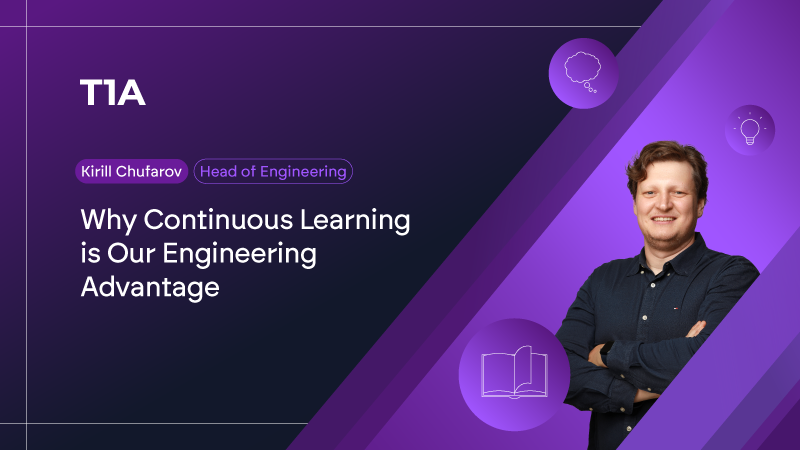


At T1A we believe that innovation doesn't come from processes and tools alone, it comes from the people who understand how to leverage them, challenge them, and apply them in new, demanding environments. To nurture this mindset, our Data Engineering Practice launched "What's New" sessions several years ago: monthly 60-minute internal meetings where engineers, analysts, architects and project managers share knowledge, discuss practical tool applications and explore real-world project use cases together.
"'New' doesn't mean fresh off yesterday's release," says Kirill Chufarov, Head of Data Engineering. "It means relevant to our clients, useful for our project teams, and worth sharing with others."
Each session is hosted by a project team lead and features one or more presenters from the DE practice. The format adapts to the story being told, but the goal remains constant: transform real project experience, technical exploration, and lessons learned into actionable collective knowledge that increases the value we deliver to clients.
The team typically covers three major areas:
Our recent sessions demonstrate the depth and practical value of these conversations. In "Building a Global Snowflake Platform from the Ground Up," Ivan Baranov shared the architecture behind a new enterprise data platform for a global agricultural client - one navigating distributed teams, legacy constraints, and a strict "fully private" networking requirement. He walked through their approach to long-distance ingestion using Azure Data Factory (including locations with bandwidth as low as 100Mbps), explained the decision to manage their own ADLS rather than rely on Snowflake's native storage, and detailed how the team balanced cost efficiency with reliability across six countries.
The team also examined the realities of migration tooling: what works well in modern data frameworks, and what still needs refinement, where some tool limitations slow down engineering workflows, and how our engineers adapt to these limitations to deliver projects on time with high quality.
Another session explored AI-assisted migration - specifically, using agents to deploy and iteratively fix Alchemist-converted SAS code on Databricks. The conversation was refreshingly candid: agents can dramatically accelerate development, but only when you break tasks into sufficiently small chunks and rigorously verify every output. As Dmitriy Alkhimov put it: "You'll write less code, but you'll check more."
T1Aers Boris Vasilev and Michel de Araujo also hosted a post-project review of a turnover-risk prediction model developed for a non-profit client. The team walked through the complexities of merging historical HR data from two legacy systems, navigating severe class imbalance in the dataset, and maintaining transparent communication with business stakeholders throughout. The project delivered a predictive dashboard that successfully identified employees who were at high risk of leaving the company — giving the HR team a practical, highly accurate tool for proactive intervention.
Expertise grows faster when it's shared, and these sessions scale knowledge across the entire team. Our clients benefit when every engineer learns from cross-industry projects, bringing synergetic solutions to new challenges. Data engineering and generative AI aren't static fields — they evolve with every architecture decision, every migration, and every line of code we refactor or design. "What's New" sessions are how we stay curious, sharpen our thinking, and build a culture where continuous learning isn't just encouraged - it's embedded in how we work.